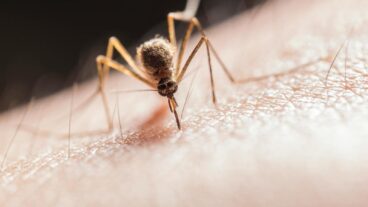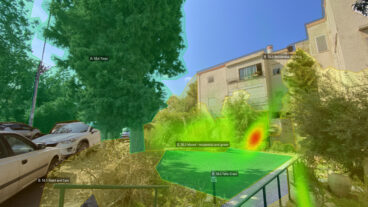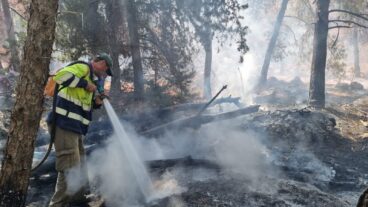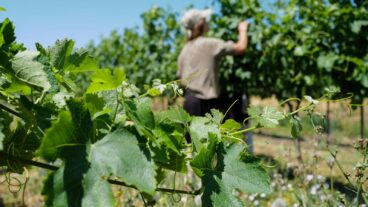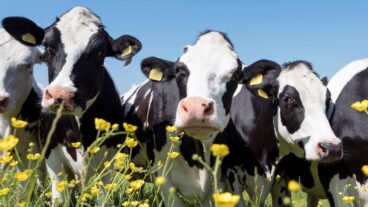Dr. Elaine Solowey shows visitor the Dalai Lama one of the Tibetan medicinal herbs she has cultivated in her experimental orchard.
A group of tourists treks its way into the Kibbutz Ketura Experimental Orchard, about 30 minutes north of Israel’s resort of Eilat. Here in the heart of the vastly arid Arava Valley, where the thirsty soil implores for rain, the group is suddenly surrounded with a phenomenal contrast of green.
They are led to a row of marulas trees indigenous to the Sudano-Sahelian range of West Africa. With a wide-spreading crown of leaves, the exotic-looking marula provides ample shade for the group to rest. Their guide explains that besides the tree’s exuberant appearance, its fruits may be used for the production of ethanol, sun skin oil, alcoholic drinks, and emergency food.
Next, the group is taken towards the argania trees. Endemic to the Sous Valley of Morocco, the eight-meter high trees bear a sweet-smelling fruit that is used to produce argan oil. UNESCO has recently designated the argan forests in Morocco as a biosphere reserve in order to prevent their extinction.
Reason followed by curiosity soon kicks in and the question pops up. Why are these trees, wild and indigenous to Africa, garnishing an orchard in the Negev desert in Israel?
The answer is Dr. Elaine Solowey. Restlessly swinging back and forth from managing the experimental orchard at Kibbutz Ketura, teaching at the Arava Institute for Environmental Studies, and conducting research for MERC/AID and for the Natural Medicines Unit of Hadassah Hospital in Jerusalem, Solowey single-handedly founded the orchard 33 years ago. Since then it has served as a ground for research on the domestication of wild medicinal plants and the preservation of endangered species.
“There is a great need for new medicines in Israel,” Solowey told ISRAEL21c, sitting in her white caravan-turned-office, drowning in paper work and books. “The best place to look is in places that haven’t been examined and analyzed. We utilize only a very small amount of the botanical capital of the world.”
Growing up in San Joaquin, California, Solowey was always fascinated by horticulture. Her aptitude and interest in trees as a child would later prompt her to study commercial horticulture at UC Davis.
Progressively, as Solowey’s passion for farming and agricultural research grew, she became more revolted by what she described as the “destructive force of corporate farming” which has “replaced human labor with machinery and replaced compost with nitrogen based fertilizer.”
In 1974, she moved to Israel and joined the newly founded Kibbutz Ketura to become their agriculture expert. That year, she planted the kibbutz’s date orchard, which today is one of its predominant sources of income. During the digging process for the date orchard, Solowey noticed an acacia tree standing alone.
“I made them leave the acacia tree standing when they were digging for the date orchard. It seemed like there was a whole ecosystem in the triangle patch in the north of the orchard,” she said. So working from that vantage point, Solowey began experimenting with new wild crops from other arid regions of the world leading to today’s internationally recognized experimental orchard.
Combining scientific research with a search for applied profitable farming for farmers in arid climates, in 1975, Solowey planted dozens of wild fruit trees and cacti in hopes of domesticating them over time. Today, 250 different varieties of trees and cacti have sprouted. Some examples include the argania which may produce cooking oil, the neem, a natural herbicide tree from India which may be used as a bulking agent for preparing food for diabetics, and the exotic-looking pitaya which is rich in anti-oxidants.
Director of the Arava Institute’s Center for Sustainable Agriculture, Solowey, a mother of six, has left an impressive track record. Through her different cooperative research projects, two highly cited books in her field – Small Steps Towards Abundance and Supping at God’s Table – and past coverage of her work by mainstream media, Solowey has acquired a prestigious reputation. Notably in 2005, after germinating a sapling from a 2,000-year-old date palm seed believed to be from ancient Judea, Solowey’s work was featured in the New York Times, National Geographic and other publications.
She was recently featured in Time magazine for her groundbreaking work in the cultivation of Tibetan medicinal herbs. In addition, she was the primary lecturer at the Indigenous Fruit Tree Conference, held by the Food and Agriculture organization of the United Nations at Matopos Reserve in Bulweyo, Zimbabwe in May 2003.
Solowey rushes back and forth from the orchard in her khaki trousers, thick-rimmed sunglasses and paper-suitcase in hand. Talking outside the library, where she works her duty kibbutz ‘toranut’ (shifts), she explains that in Biblical times, the Arava expanse was more fertile and included a string of interconnected oases. Today, beyond her innovative research, Solowey also believes in combating desertification – the greening of the desert.
The main funding for her orchard, Solowey explains, comes from institutional grants from the US such as GM, Arid Lands Consortium, and MERC/AID. “You cannot support yourself on grants coming from Israel,” she laments, “there just isn’t enough investment by the government and its institutions in agricultural research.”
These days, she says, various crops which she has been cultivating over the last decades such as the “argania, marula, sapodilla, capers, prosopis, and neem” are now domesticated and soon will be ready to be planted in commercial orchards. And the idea is to continue diversifying her research and expanding on the variety of crops available.
A major problem with corporate farming nowadays, Solowey argues, is that there has been shrinkage in the variety of crops available to human beings. Take sweet corn for instance, she elaborates. Whereas there were hundreds of kinds of sweet corn centuries ago, today, the monocultural tendencies of corporate farming have reduced the many varieties to three or four.
“This makes the system very vulnerable to pandemics,” says Solowey. “In uniformity there is horrible vulnerability. It’s an absolute necessity to have a wide variety of crops with a great deal of in-crop diversity to maintain healthy farming systems.”
Despite her work to promote idealist agricultural practices, Solowey says it’s a drop in the sea, and bemoans the destructive force of corporate farming.
“Agribusiness is a delusion,” says Solowey using the deriding nomenclature for corporate farming. “It threatens our survival. Very few people know how to farm nowadays. The systems are vast and oversimplified, also very vulnerable to disease and pests. Farming is also getting more expensive as oil prices go up.”
When asked about the future of agriculture and food sources, Solowey cautions against stagnation. “We had better improve the situation before the system crashes. Or else there will be great hunger in the world.” ![]()




